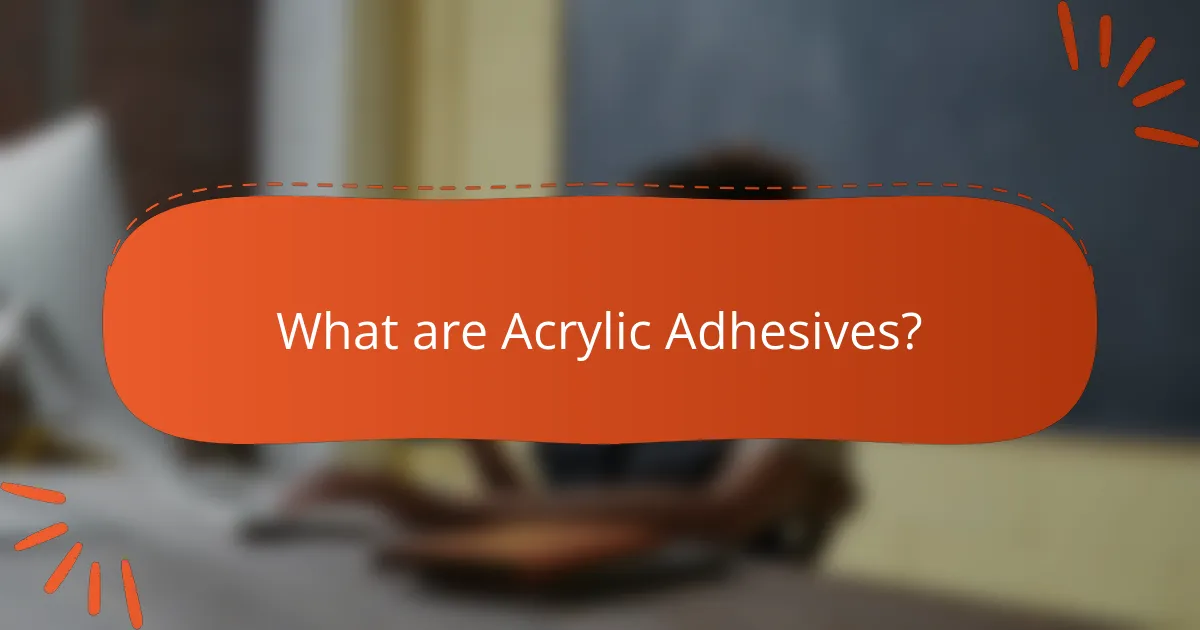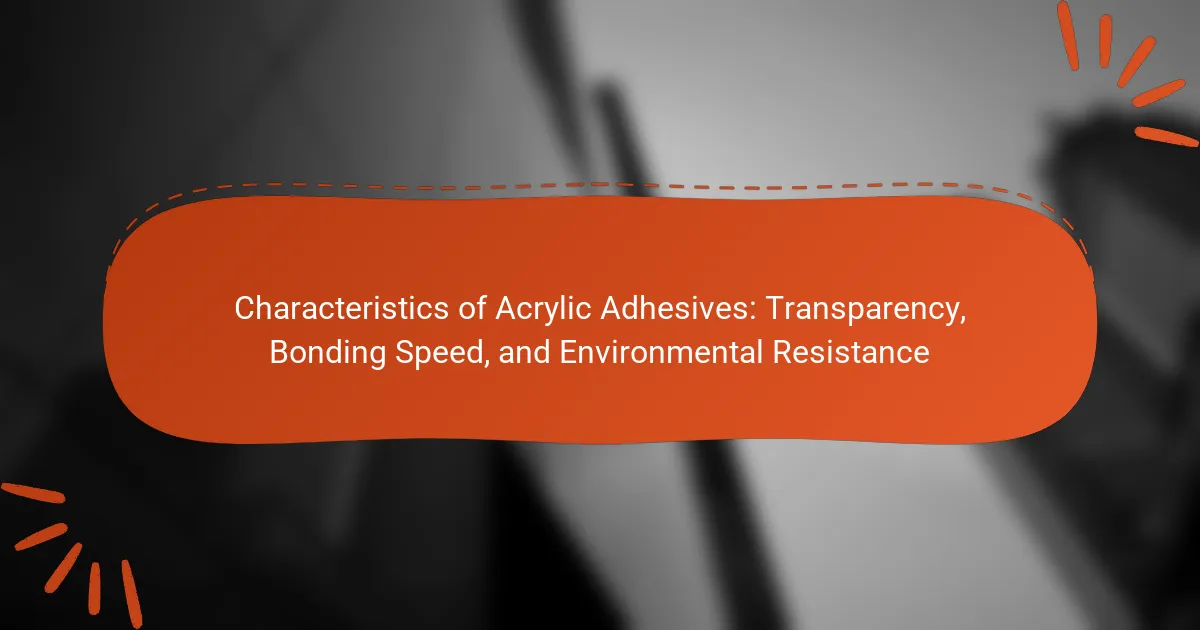Acrylic adhesives are synthetic adhesives derived from acrylic polymers, recognized for their strong bonding capabilities and versatility across various materials, including plastics, metals, and glass. Key characteristics of acrylic adhesives include fast curing times, environmental resistance to moisture and UV light, and optical clarity, which is essential for aesthetic applications. Their performance in demanding conditions makes them suitable for industries such as automotive, construction, and electronics. The article will explore the importance of transparency, bonding speed, and environmental resistance in acrylic adhesives, highlighting their role in enhancing product integrity and longevity.

What are Acrylic Adhesives?
Acrylic adhesives are synthetic adhesives made from acrylic polymers. They are known for their strong bonding capabilities and versatility. Acrylic adhesives can bond a variety of materials, including plastics, metals, and glass. They are often used in industries such as automotive, construction, and electronics. One key feature of acrylic adhesives is their fast curing time, which allows for quick assembly processes. Additionally, these adhesives are resistant to environmental factors like moisture and UV light. Their transparency makes them ideal for applications where aesthetics are important. Overall, acrylic adhesives provide reliable performance in demanding conditions.
How do Acrylic Adhesives differ from other types of adhesives?
Acrylic adhesives differ from other types of adhesives primarily in their chemical composition and bonding properties. They are based on acrylic polymers, which provide superior clarity and UV resistance. Unlike epoxy adhesives, acrylic adhesives cure quickly, enabling faster assembly times. Their flexibility allows for movement without compromising bond strength. Acrylic adhesives also exhibit excellent environmental resistance, making them suitable for outdoor applications. In contrast, many other adhesives may degrade under UV exposure or moisture. Studies show that acrylic adhesives maintain their integrity in harsh conditions better than traditional adhesives.
What are the chemical compositions of Acrylic Adhesives?
Acrylic adhesives primarily consist of acrylic polymers. These polymers are made from monomers such as methyl methacrylate and butyl acrylate. The chemical composition can vary based on the specific formulation. Other components may include stabilizers, fillers, and solvents. These additives enhance properties like viscosity and bonding strength. The ratio of these components influences the adhesive’s performance. Acrylic adhesives are known for their strong bonding capabilities and resistance to environmental factors. Their chemical structure allows for flexibility and durability in various applications.
What are the common applications of Acrylic Adhesives?
Acrylic adhesives are commonly used in various industries due to their strong bonding capabilities. They are frequently applied in automotive manufacturing for assembling components. Acrylic adhesives are also utilized in the construction industry for bonding materials like glass and metal. They are popular in electronics for securing components and providing insulation. In the medical field, acrylic adhesives are used for assembling devices and wound dressings. Their resistance to environmental factors makes them ideal for outdoor applications. Additionally, acrylic adhesives find use in crafts and DIY projects for their versatility. Their quick bonding speed enhances productivity across these applications.
What are the key characteristics of Acrylic Adhesives?
Acrylic adhesives are known for their excellent transparency and strong bonding capabilities. They provide a clear bond that is aesthetically pleasing. The bonding speed of acrylic adhesives is generally fast, allowing for quick assembly in various applications. They exhibit good environmental resistance, maintaining performance under varying temperature and humidity conditions. Acrylic adhesives also possess good flexibility, which helps them accommodate movement in bonded materials. Additionally, they are resistant to UV light, making them suitable for outdoor applications. Their versatility allows them to bond a wide range of substrates, including metals, plastics, and glass.
How does transparency impact the performance of Acrylic Adhesives?
Transparency affects the performance of acrylic adhesives by influencing their aesthetic appeal and functional properties. High transparency allows for seamless bonding in visible applications. This characteristic is critical in industries such as automotive and construction, where appearance matters. Enhanced transparency often correlates with better UV resistance. Acrylic adhesives with superior transparency tend to maintain their bond strength over time. Studies show that transparent formulations can reduce yellowing and degradation. This leads to longer-lasting performance in exposed environments. Therefore, transparency is a key factor in the overall effectiveness of acrylic adhesives.
What factors contribute to the bonding speed of Acrylic Adhesives?
The bonding speed of acrylic adhesives is influenced by several factors. These include temperature, surface preparation, and adhesive formulation. Higher temperatures generally increase the bonding speed due to enhanced molecular movement. Proper surface preparation, such as cleaning and roughening, promotes better adhesion and faster bonding. Additionally, the specific formulation of the adhesive, including the presence of accelerators or additives, can significantly affect the curing time. Research indicates that optimal environmental conditions can lead to a bonding speed increase of up to 50% in some formulations.
How do environmental conditions affect Acrylic Adhesives?
Environmental conditions significantly influence the performance of acrylic adhesives. Temperature variations can affect curing times and bond strength. High humidity can lead to moisture absorption, weakening the adhesive bond. UV exposure may cause degradation over time, impacting transparency and adhesion. Additionally, extreme temperatures can result in brittleness or excessive flexibility. Research indicates that optimal bonding occurs within specific temperature and humidity ranges. For instance, a study by the Adhesive and Sealant Council found that acrylic adhesives perform best at temperatures between 60°F and 80°F.

What is the significance of Transparency in Acrylic Adhesives?
Transparency in acrylic adhesives is crucial for aesthetic and functional applications. It allows for seamless bonding in visible areas, enhancing the overall appearance of the finished product. The clarity ensures that the adhesive does not detract from the visual integrity of materials being joined. Additionally, transparency aids in monitoring the adhesive layer during application. This characteristic is particularly important in industries such as automotive and electronics, where appearance and functionality are paramount. Research shows that the optical clarity of acrylic adhesives contributes to their widespread use in glass bonding and other transparent materials.
Why is transparency important in adhesive applications?
Transparency is important in adhesive applications because it affects the aesthetic quality of the finished product. Adhesives that are transparent ensure that the bond remains visually unobtrusive. This is crucial in applications such as glass bonding or in crafts where appearance matters. Transparent adhesives allow for a seamless look, enhancing the overall design. According to a study by the Adhesive and Sealant Council, clear adhesives are preferred in consumer products for their visual appeal. Additionally, transparency can indicate the cleanliness and quality of the adhesive. Clear adhesives also help in assessing the bond line during application, ensuring proper coverage and adhesion.
How does the clarity of Acrylic Adhesives enhance aesthetic appeal?
The clarity of acrylic adhesives enhances aesthetic appeal by providing a transparent bond that is visually unobtrusive. This transparency allows the underlying materials to remain visible, preserving their original appearance. Acrylic adhesives are often used in applications where aesthetics are crucial, such as in glass bonding or decorative elements. Their clarity ensures that the adhesive does not detract from the overall look of the assembled products. Additionally, the high optical clarity of these adhesives can improve the perceived quality of the final product. Studies have shown that clear adhesives can significantly enhance the visual appeal of displays and installations, making them more attractive to consumers.
What industries prioritize the transparency of adhesives?
The industries that prioritize the transparency of adhesives include the automotive, electronics, and construction sectors. In the automotive industry, transparent adhesives are essential for bonding glass and components without compromising aesthetics. Electronics manufacturers require clear adhesives for assembling devices while ensuring visibility and functionality. The construction industry utilizes transparent adhesives for applications like glass facades and interior design elements. These industries emphasize transparency to maintain visual appeal and performance in their products.
How does Bonding Speed affect the usability of Acrylic Adhesives?
Bonding speed significantly affects the usability of acrylic adhesives. Faster bonding speeds can enhance the efficiency of assembly processes. This allows for quicker production times in manufacturing settings. Additionally, rapid bonding can reduce the time components are exposed to potential contaminants. However, if the bonding speed is too fast, it may lead to improper adhesion. This can compromise the strength and durability of the bond. Optimal bonding speeds are typically recommended for specific applications. For instance, a study by the Adhesive and Sealant Council indicates that bonding speed can influence the final bond strength. Properly managing bonding speed ensures effective application and performance of acrylic adhesives.
What factors influence the bonding speed of Acrylic Adhesives?
The bonding speed of acrylic adhesives is influenced by several factors. Temperature plays a significant role; higher temperatures generally accelerate the curing process. Humidity levels also affect bonding speed; increased humidity can enhance the adhesive’s performance. The surface preparation of the materials being bonded is crucial; clean, roughened surfaces promote better adhesion. Additionally, the type and formulation of the acrylic adhesive impact bonding speed; some formulations cure faster than others. The thickness of the adhesive layer can influence speed; thinner layers typically bond more quickly. Finally, the presence of accelerators or catalysts in the adhesive formulation can significantly increase the bonding speed.
How can users optimize bonding speed in practical applications?
Users can optimize bonding speed in practical applications by ensuring proper surface preparation. Clean and dry surfaces enhance adhesive performance. Users should also apply the adhesive evenly to avoid weak spots. Maintaining optimal temperature and humidity levels can accelerate curing times. Using accelerators or heat can further speed up the bonding process. Selecting the right acrylic adhesive for specific materials is crucial. Some adhesives are formulated for faster curing on certain substrates. According to manufacturer guidelines, following recommended application techniques can significantly improve bonding speed.

What role does Environmental Resistance play in the performance of Acrylic Adhesives?
Environmental resistance significantly impacts the performance of acrylic adhesives. It determines their durability and effectiveness in various conditions. Acrylic adhesives with high environmental resistance can withstand moisture, UV radiation, and temperature fluctuations. These factors contribute to the longevity of the adhesive bond. For instance, moisture resistance prevents bond degradation in humid environments. UV resistance ensures that the adhesive maintains its integrity when exposed to sunlight. Temperature resistance allows the adhesive to perform effectively across a range of temperatures. Research indicates that acrylic adhesives designed for outdoor applications often include additives to enhance environmental resistance. This ensures optimal performance in challenging conditions.
How do Acrylic Adhesives perform under different environmental conditions?
Acrylic adhesives exhibit strong performance under various environmental conditions. They maintain adhesion in a wide temperature range, typically from -40°F to 200°F. Their resistance to moisture and UV light contributes to their durability. Acrylic adhesives also demonstrate good chemical resistance, making them suitable for diverse applications. Studies show that their bond strength remains stable even in high humidity. Additionally, they can withstand exposure to solvents without significant degradation. These attributes make acrylic adhesives reliable for both indoor and outdoor uses.
What are the common environmental challenges faced by Acrylic Adhesives?
Acrylic adhesives face several common environmental challenges. These include sensitivity to moisture, which can weaken bond strength. Exposure to UV radiation can lead to degradation and loss of clarity. Temperature fluctuations can affect the curing process and overall performance. Additionally, chemical exposure can compromise adhesive integrity. These factors can limit the effectiveness and longevity of acrylic adhesives in various applications.
How can users ensure the longevity of Acrylic Adhesives in harsh conditions?
Users can ensure the longevity of acrylic adhesives in harsh conditions by selecting the right formulation. Specific acrylic adhesives are designed for high-temperature and moisture-resistance applications. Proper surface preparation is crucial; surfaces should be clean, dry, and free from contaminants. Applying the adhesive in optimal temperature ranges enhances bond strength and durability. Users should also consider using primers to improve adhesion on challenging substrates. Storage conditions matter; keeping adhesives in a cool, dry place prolongs shelf life. Regularly checking the adhesive’s expiration date ensures effectiveness. Finally, following manufacturer guidelines for application and curing times is essential for optimal performance.
What are best practices for using Acrylic Adhesives effectively?
To use acrylic adhesives effectively, ensure proper surface preparation. Clean surfaces to remove dust, grease, and contaminants. Apply the adhesive evenly for optimal bonding. Use clamps or weights to hold parts together during curing. Maintain the recommended temperature and humidity levels for best results. Allow adequate curing time before applying stress to the bond. Store adhesives in a cool, dry place to extend shelf life. Follow manufacturer guidelines for specific application techniques. These practices enhance the adhesive’s performance and durability.
How can users troubleshoot common issues with Acrylic Adhesives?
Users can troubleshoot common issues with acrylic adhesives by following specific steps. First, ensure surfaces are clean and dry. Contaminants can prevent proper adhesion. Second, check the adhesive’s expiration date. Expired adhesives may not bond effectively. Third, apply the adhesive evenly. Uneven application can lead to weak bonds. Fourth, maintain the recommended temperature during application. Temperature fluctuations can affect curing time and bond strength. Fifth, allow adequate curing time. Insufficient curing can result in poor adhesion. Finally, if issues persist, consider using a different type of adhesive better suited for the materials involved.
What tips can enhance the performance of Acrylic Adhesives in various applications?
To enhance the performance of acrylic adhesives, ensure proper surface preparation. Clean surfaces remove contaminants that can weaken the bond. Use a primer when bonding difficult substrates for improved adhesion. Apply adhesive at the recommended temperature for optimal curing. Control the humidity during application to prevent moisture interference. Allow adequate curing time before applying stress to the bond. Use clamps or weights to maintain contact during curing for a stronger bond. Finally, consider the adhesive’s specific formulation for compatibility with the materials being bonded.
Acrylic adhesives are synthetic bonding agents derived from acrylic polymers, recognized for their strong bonding capabilities, fast curing times, and resistance to environmental factors. This article explores the key characteristics of acrylic adhesives, including their transparency, which enhances aesthetic appeal in applications, and their bonding speed, which affects usability in manufacturing processes. Additionally, the article examines the environmental resistance of these adhesives, detailing how they perform under varying conditions and the common challenges they face. Best practices for effective use and troubleshooting of acrylic adhesives are also discussed, providing a comprehensive overview of their applications across multiple industries.



